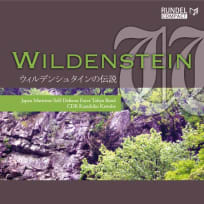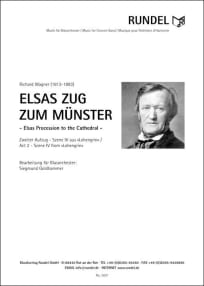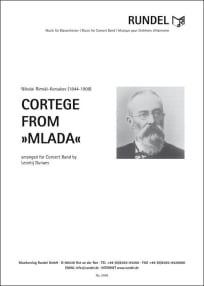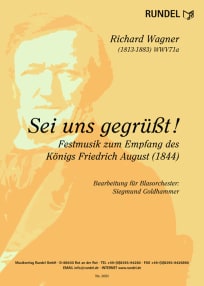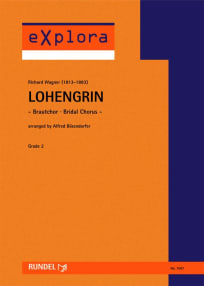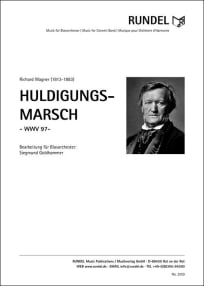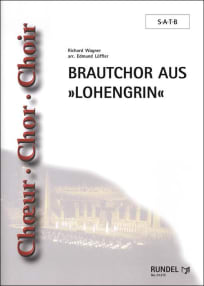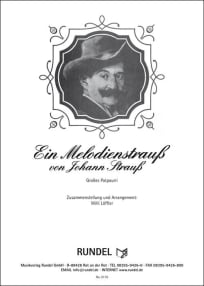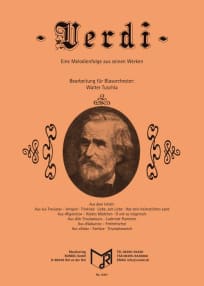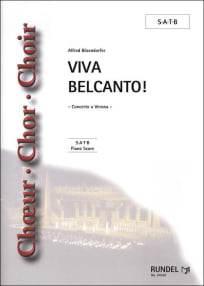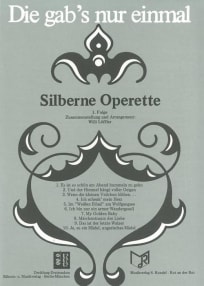Concert Band
Tannhäuser Festival
Richard Wagner
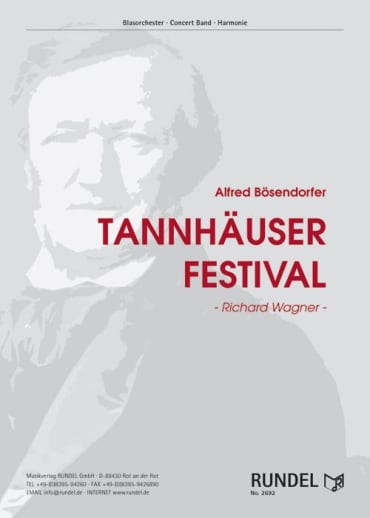
Concert Band
Tannhäuser Festival
Richard Wagner
Composer
Performance time
00:09:30
Grade Level
Oberstufe
Publisher
Rundel
Size
A4
Info
Full Score + Parts
Order Number
MVSR2692
Release Date
2013
Info
Richard Wagner is mainly famous for his great and unique dramatic works, where he developed a comprehensive, holstic style as composer, librettist and stage director. His best-known operas are "Rienzi", "The Flying Dutchman", "Tannhäuser", "Lohengrin”, "The Ring of the Nibelung", "Tristan and Isolde", "The Mastersingers of Nuremberg" and "Parsifal". Wagner liked the sound of wind instruments and often used big brass sections in his works for symphony orchestra. He also composed pieces just for wind orchestra, mostly for open air performances. Yet, in his time this formation was not as refined as today. One cannot compare the instrument technology and ensemble colors of today to those of the past. Thus arises the question: If Wagner had been able to work with today’s wind bands, how would he have composed for this format? Would he have used saxophones? What effects would he have created with percussion? Would he have preferred the tonal color of the wind band to that of the symphony orchestra? Alfred Boesendorfer gives possible answers to those questions in his work "Tannhäuser Festival", which is more than a collection of the most beautiful melodies of various Wagner operas. Rather than just a series of excerpts, he created a logical, unique construction. The original "Tannhäuser" has few musical endings as the passages blend into each other as an "infinite melody", which is a typical element of Wagner’s dramatic works. Boesendorfer devoted himself to the structure of the opera and created self-contained segments, which he combined rationally. To reduce a four-hour opera to a ten-minute concert piece for wind band requires not only deep involvement with the musical material – he also had to create a new dramaturgy to retain the effect and authenticity of the work without overtaxing or boring the audience. In "Tannhäuser Festival", Alfred Boesendorfer interprets Wagner’s music in a completely new way for wind band and skilfully adapts it to the conditions of this versatile formation. Wagner himself might have envisioned these new wind band colors.
Fest Fanfare (Einzug der Gäste – Entry of the Guests)
Gebet der Elisabeth – Elisabeth’s Prayer
Wolfram allein – Wolfram alone
Aus der Ferne – At a Distance
Chor der älteren Pilger – Chorus of Older Pilgrims
Maestoso (Gnadenheil-Motiv) – „Gnadenheil“ Motif
Fest Fanfare (Einzug der Gäste – Entry of the Guests)
Gebet der Elisabeth – Elisabeth’s Prayer
Wolfram allein – Wolfram alone
Aus der Ferne – At a Distance
Chor der älteren Pilger – Chorus of Older Pilgrims
Maestoso (Gnadenheil-Motiv) – „Gnadenheil“ Motif
Keywords
atemberaubend
RUNDEL Promo-Katalog 2013
dynamisch
kontrastreich
groß
Richard Wagner
Bayreuth
Arrangement / Transcription
Arrival
Classical Music
colorful
dramatic
Fairy Tale / Story / Saga / Legend / Fable
Fanfare
German composers
God
Heroes
Love
Medley
Mystery / Secret
Opera
Orchestral Transcriptions
pray
Prayer
prayerful
RUNDEL YouTube Channel
solemn
symphonic
tragic
Victory
Woman / Women
Listen & read from the Rundel YouTube Channel
RUNDEL VIDEO
Tannhäuser Festival
Notes available at:
https://www.rundel.de/en/
Richard Wagner
Richard Wagner is mainly famous for his great and unique dramatic works, where he developed a comprehensive, holstic style as composer, librettist and stage director. His best-known operas are "Rienzi", "The Flying Dutchman", "Tannhäuser", "Lohengrin”, "The Ring of the Nibelung", "Tristan and Isolde", "The Mastersingers of Nuremberg" and "Parsifal". Wagner liked the sound of wind instruments and often used big brass sections in his works for symphony orchestra. He also composed pieces just for wind orchestra, mostly for open air performances. Yet, in his time this formation was not as refined as today. One cannot compare the instrument technology and ensemble colors of today to those of the past. Thus arises the question: If...
https://www.rundel.de/en/
Richard Wagner
Richard Wagner is mainly famous for his great and unique dramatic works, where he developed a comprehensive, holstic style as composer, librettist and stage director. His best-known operas are "Rienzi", "The Flying Dutchman", "Tannhäuser", "Lohengrin”, "The Ring of the Nibelung", "Tristan and Isolde", "The Mastersingers of Nuremberg" and "Parsifal". Wagner liked the sound of wind instruments and often used big brass sections in his works for symphony orchestra. He also composed pieces just for wind orchestra, mostly for open air performances. Yet, in his time this formation was not as refined as today. One cannot compare the instrument technology and ensemble colors of today to those of the past. Thus arises the question: If...


